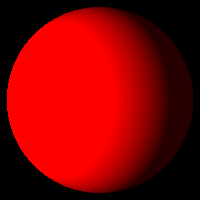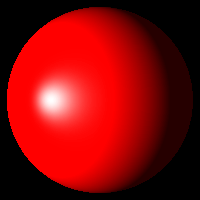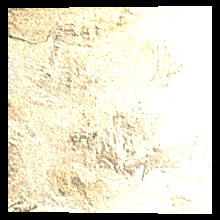DirectX 10 教程10:镜面高光
原文地址:Tutorial 10: Specular Lighting(http://www.rastertek.com/dx10tut10.html)。
源代码:dx10tut10.zip。
本教程介绍如何使用镜面高光,代码基于前一个教程。
镜面高光相当于使用一个亮度很高的光源在物体表面显示出光源位置的效果。例如,只使用漫反射和环境光效果的红色球模型的图像如下图所示:

如果添加了高光效果后如下图所示:

镜面高光主要用于在有金属光泽(例如镜子)的表面产生光亮的效果,也用于类似于反射阳光的水面的材质,使用得当可以给3D场景添加照片级的效果。镜面高光的方程如下所示:
SpecularLighting = SpecularColor * (SpecularColorOfLight * ((NormalVector dot HalfWayVector) power SpecularReflectionPower) * Attentuation * Spotlight)
我们简化了上面的方程获得了一个基本的镜面高光效果:
SpecularLighting = SpecularLightColor * (ViewingDirection dot ReflectionVector) power SpecularReflectionPower
方程中的反射矢量公式如下,最后的结果表示入射光线在表面反射的矢量(译者注:背后的数学原理可参见22. Generic.fx的实现):
ReflectionVector = 2 * LightIntensity * VertexNormal - LightDirection
方程中的观察方向是由相机位置减去顶点位置计算得来的。
ViewingDirection = CameraPosition - VertexPosition
首先看一下修改过的light shader。
Light.fx
//////////////////////////////////////////////////////////////////////////////// // Filename: light.fx //////////////////////////////////////////////////////////////////////////////// ///////////// // GLOBALS // ///////////// matrix worldMatrix; matrix viewMatrix; matrix projectionMatrix; Texture2D shaderTexture; float4 ambientColor; float4 diffuseColor; float3 lightDirection;
添加了三个新变量:cameraPosition,specularColor和specularPower用于镜面高光的计算。
float3 cameraPosition;
float4 specularColor;
float specularPower;
///////////////////
// SAMPLE STATES //
///////////////////
SamplerState SampleType
{
Filter = MIN_MAG_MIP_LINEAR;
AddressU = Wrap;
AddressV = Wrap;
};
//////////////
// TYPEDEFS //
//////////////
struct VertexInputType
{
float4 position : POSITION;
float2 tex : TEXCOORD0;
float3 normal : NORMAL;
};
PixelInputType需要添加观察方向,这个方向是在顶点着色器中计算的,然后发送到像素着色器用于镜面高光计算。
struct PixelInputType
{
float4 position : SV_POSITION;
float2 tex : TEXCOORD0;
float3 normal : NORMAL;
float3 viewDirection : TEXCOORD1;
};
////////////////////////////////////////////////////////////////////////////////
// Vertex Shader
////////////////////////////////////////////////////////////////////////////////
PixelInputType LightVertexShader(VertexInputType input)
{
PixelInputType output;
float4 worldPosition;
// Change the position vector to be 4 units for proper matrix calculations.
input.position.w = 1.0f;
// Calculate the position of the vertex against the world, view, and projection matrices.
output.position = mul(input.position, worldMatrix);
output.position = mul(output.position, viewMatrix);
output.position = mul(output.position, projectionMatrix);
// Store the texture coordinates for the pixel shader.
output.tex = input.tex;
// Calculate the normal vector against the world matrix only.
output.normal = mul(input.normal, (float3x3)worldMatrix);
// Normalize the normal vector.
output.normal = normalize(output.normal);
观察方向是在顶点着色器中计算的。我们先将顶点位置转换到世界空间,然后用相机位置减去这个顶点位置,结果就是顶点指向相机的方向。经过归一化后这个值被发送到像素着色器。
// Calculate the position of the vertex in the world.
worldPosition = mul(input.position, worldMatrix);
// Determine the viewing direction based on the position of the camera and the position of the vertex in the world.
output.viewDirection = cameraPosition.xyz - worldPosition.xyz;
// Normalize the viewing direction vector.
output.viewDirection = normalize(output.viewDirection);
return output;
}
////////////////////////////////////////////////////////////////////////////////
// Pixel Shader
////////////////////////////////////////////////////////////////////////////////
float4 LightPixelShader(PixelInputType input) : SV_Target
{
float4 textureColor;
float3 lightDir;
float lightIntensity;
float4 color;
float3 reflection;
float4 specular;
// Sample the pixel color from the texture using the sampler at this texture coordinate location.
textureColor = shaderTexture.Sample(SampleType, input.tex);
// Set the default output color to the ambient light value for all pixels.
color = ambientColor;
// Initialize the specular color.
specular = float4(0.0f, 0.0f, 0.0f, 0.0f);
// Invert the light direction for calculations.
lightDir = -lightDirection;
// Calculate the amount of light on this pixel.
lightIntensity = saturate(dot(input.normal, lightDir));
if(lightIntensity > 0.0f)
{
// Determine the final diffuse color based on the diffuse color and the amount of light intensity.
color += (diffuseColor * lightIntensity);
// Saturate the ambient and diffuse color.
color = saturate(color);
下面的代码计算用于镜面高光的反射向量:
// Calculate the reflection vector based on the light intensity, normal vector, and light direction.
reflection = normalize(2 * lightIntensity * input.normal - lightDir);
然后使用反射向量和观察向量计算镜面高光强度。反射向量与观察方向的夹角越小,反射越强烈。结果还要进行幂运算,指数为specularPower,这个值越大,反射越强烈。
// Determine the amount of specular light based on the reflection vector, viewing direction, and specular power.
specular = pow(saturate(dot(reflection, input.viewDirection)), specularPower);
}
// Multiply the texture pixel and the input color to get the textured result.
color = color * textureColor;
最后将镜面高光附加到最终的颜色上。
// Add the specular component last to the output color.
color = saturate(color + specular);
return color;
}
////////////////////////////////////////////////////////////////////////////////
// Technique
////////////////////////////////////////////////////////////////////////////////
technique10 LightTechnique
{
pass pass0
{
SetVertexShader(CompileShader(vs_4_0, LightVertexShader()));
SetPixelShader(CompileShader(ps_4_0, LightPixelShader()));
SetGeometryShader(NULL);
}
}
Lightshaderclass.h
LightShaderClass因为需要处理镜面高光需要进行修改。
////////////////////////////////////////////////////////////////////////////////
// Filename: lightshaderclass.h
////////////////////////////////////////////////////////////////////////////////
#ifndef _LIGHTSHADERCLASS_H_
#define _LIGHTSHADERCLASS_H_
//////////////
// INCLUDES //
//////////////
#include <d3d10.h>
#include <d3dx10math.h>
#include <fstream>
using namespace std;
////////////////////////////////////////////////////////////////////////////////
// Class name: LightShaderClass
////////////////////////////////////////////////////////////////////////////////
class LightShaderClass
{
public:
LightShaderClass();
LightShaderClass(const LightShaderClass&);
~LightShaderClass();
bool Initialize(ID3D10Device*, HWND);
void Shutdown();
void Render(ID3D10Device*, int, D3DXMATRIX, D3DXMATRIX, D3DXMATRIX, ID3D10ShaderResourceView*, D3DXVECTOR3, D3DXVECTOR4, D3DXVECTOR4, D3DXVECTOR3,
D3DXVECTOR4, float);
private:
bool InitializeShader(ID3D10Device*, HWND, WCHAR*);
void ShutdownShader();
void OutputShaderErrorMessage(ID3D10Blob*, HWND, WCHAR*);
void SetShaderParameters(D3DXMATRIX, D3DXMATRIX, D3DXMATRIX, ID3D10ShaderResourceView*, D3DXVECTOR3, D3DXVECTOR4, D3DXVECTOR4, D3DXVECTOR3,
D3DXVECTOR4, float);
void RenderShader(ID3D10Device*, int);
private:
ID3D10Effect* m_effect;
ID3D10EffectTechnique* m_technique;
ID3D10InputLayout* m_layout;
ID3D10EffectMatrixVariable* m_worldMatrixPtr;
ID3D10EffectMatrixVariable* m_viewMatrixPtr;
ID3D10EffectMatrixVariable* m_projectionMatrixPtr;
ID3D10EffectShaderResourceVariable* m_texturePtr;
ID3D10EffectVectorVariable* m_lightDirectionPtr;
ID3D10EffectVectorVariable* m_ambientColorPtr;
ID3D10EffectVectorVariable* m_diffuseColorPtr;
新添三个指针匹配specular light shader中的变量。
ID3D10EffectVectorVariable* m_cameraPositionPtr; ID3D10EffectVectorVariable* m_specularColorPtr; ID3D10EffectScalarVariable* m_specularPowerPtr; }; #endif
Lightshaderclass.cpp
////////////////////////////////////////////////////////////////////////////////
// Filename: lightshaderclass.cpp
////////////////////////////////////////////////////////////////////////////////
#include "lightshaderclass.h"
LightShaderClass::LightShaderClass()
{
m_effect = 0;
m_technique = 0;
m_layout = 0;
m_worldMatrixPtr = 0;
m_viewMatrixPtr = 0;
m_projectionMatrixPtr = 0;
m_texturePtr = 0;
m_lightDirectionPtr = 0;
m_ambientColorPtr = 0;
m_diffuseColorPtr = 0;
在构造函数中将三个新指针设置为null。
m_cameraPositionPtr = 0;
m_specularColorPtr = 0;
m_specularPowerPtr = 0;
}
LightShaderClass::LightShaderClass(const LightShaderClass& other)
{
}
LightShaderClass::~LightShaderClass()
{
}
bool LightShaderClass::Initialize(ID3D10Device* device, HWND hwnd)
{
bool result;
// Initialize the shader that will be used to draw the triangle.
result = InitializeShader(device, hwnd, L"../Engine/light.fx");
if(!result)
{
return false;
}
return true;
}
void LightShaderClass::Shutdown()
{
// Shutdown the shader effect.
ShutdownShader();
return;
}
Render方法的参数新添了cameraPosition,specularColor和specularPower,然后将它们发送到SetShaderParameters方法,进一步设置到light shader中。
void LightShaderClass::Render(ID3D10Device* device, int indexCount, D3DXMATRIX worldMatrix, D3DXMATRIX viewMatrix, D3DXMATRIX projectionMatrix,
ID3D10ShaderResourceView* texture, D3DXVECTOR3 lightDirection, D3DXVECTOR4 ambientColor, D3DXVECTOR4 diffuseColor,
D3DXVECTOR3 cameraPosition, D3DXVECTOR4 specularColor, float specularPower)
{
// Set the shader parameters that it will use for rendering.
SetShaderParameters(worldMatrix, viewMatrix, projectionMatrix, texture, lightDirection, ambientColor, diffuseColor, cameraPosition, specularColor,
specularPower);
// Now render the prepared buffers with the shader.
RenderShader(device, indexCount);
return;
}
bool LightShaderClass::InitializeShader(ID3D10Device* device, HWND hwnd, WCHAR* filename)
{
HRESULT result;
ID3D10Blob* errorMessage;
D3D10_INPUT_ELEMENT_DESC polygonLayout[3];
unsigned int numElements;
D3D10_PASS_DESC passDesc;
// Initialize the error message.
errorMessage = 0;
// Load the shader in from the file.
result = D3DX10CreateEffectFromFile(filename, NULL, NULL, "fx_4_0", D3D10_SHADER_ENABLE_STRICTNESS, 0,
device, NULL, NULL, &m_effect, &errorMessage, NULL);
if(FAILED(result))
{
// If the shader failed to compile it should have writen something to the error message.
if(errorMessage)
{
OutputShaderErrorMessage(errorMessage, hwnd, filename);
}
// If there was nothing in the error message then it simply could not find the shader file itself.
else
{
MessageBox(hwnd, filename, L"Missing Shader File", MB_OK);
}
return false;
}
// Get a pointer to the technique inside the shader.
m_technique = m_effect->GetTechniqueByName("LightTechnique");
if(!m_technique)
{
return false;
}
// Now setup the layout of the data that goes into the shader.
// This setup needs to match the VertexType stucture in the ModelClass and in the shader.
polygonLayout[0].SemanticName = "POSITION";
polygonLayout[0].SemanticIndex = 0;
polygonLayout[0].Format = DXGI_FORMAT_R32G32B32_FLOAT;
polygonLayout[0].InputSlot = 0;
polygonLayout[0].AlignedByteOffset = 0;
polygonLayout[0].InputSlotClass = D3D10_INPUT_PER_VERTEX_DATA;
polygonLayout[0].InstanceDataStepRate = 0;
polygonLayout[1].SemanticName = "TEXCOORD";
polygonLayout[1].SemanticIndex = 0;
polygonLayout[1].Format = DXGI_FORMAT_R32G32_FLOAT;
polygonLayout[1].InputSlot = 0;
polygonLayout[1].AlignedByteOffset = D3D10_APPEND_ALIGNED_ELEMENT;
polygonLayout[1].InputSlotClass = D3D10_INPUT_PER_VERTEX_DATA;
polygonLayout[1].InstanceDataStepRate = 0;
polygonLayout[2].SemanticName = "NORMAL";
polygonLayout[2].SemanticIndex = 0;
polygonLayout[2].Format = DXGI_FORMAT_R32G32B32_FLOAT;
polygonLayout[2].InputSlot = 0;
polygonLayout[2].AlignedByteOffset = D3D10_APPEND_ALIGNED_ELEMENT;
polygonLayout[2].InputSlotClass = D3D10_INPUT_PER_VERTEX_DATA;
polygonLayout[2].InstanceDataStepRate = 0;
// Get a count of the elements in the layout.
numElements = sizeof(polygonLayout) / sizeof(polygonLayout[0]);
// Get the description of the first pass described in the shader technique.
m_technique->GetPassByIndex(0)->GetDesc(&passDesc);
// Create the input layout.
result = device->CreateInputLayout(polygonLayout, numElements, passDesc.pIAInputSignature, passDesc.IAInputSignatureSize, &m_layout);
if(FAILED(result))
{
return false;
}
// Get pointers to the three matrices inside the shader so we can update them from this class.
m_worldMatrixPtr = m_effect->GetVariableByName("worldMatrix")->AsMatrix();
m_viewMatrixPtr = m_effect->GetVariableByName("viewMatrix")->AsMatrix();
m_projectionMatrixPtr = m_effect->GetVariableByName("projectionMatrix")->AsMatrix();
// Get pointer to the texture resource inside the shader.
m_texturePtr = m_effect->GetVariableByName("shaderTexture")->AsShaderResource();
// Get pointers to the light direction and diffuse color variables inside the shader.
m_lightDirectionPtr = m_effect->GetVariableByName("lightDirection")->AsVector();
m_ambientColorPtr = m_effect->GetVariableByName("ambientColor")->AsVector();
m_diffuseColorPtr = m_effect->GetVariableByName("diffuseColor")->AsVector();
下面的代码设置三个新指针,这样就可以访问shader中的对应变量。
// Get pointers to the specular light components inside the shader.
m_cameraPositionPtr = m_effect->GetVariableByName("cameraPosition")->AsVector();
m_specularColorPtr = m_effect->GetVariableByName("specularColor")->AsVector();
m_specularPowerPtr = m_effect->GetVariableByName("specularPower")->AsScalar();
return true;
}
void LightShaderClass::ShutdownShader()
{
三个新指针在ShutdownShader方法中释放。
// Release the light pointers.
m_cameraPositionPtr = 0;
m_specularColorPtr = 0;
m_specularPowerPtr = 0;
m_lightDirectionPtr = 0;
m_ambientColorPtr = 0;
m_diffuseColorPtr = 0;
// Release the pointer to the texture in the shader file.
m_texturePtr = 0;
// Release the pointers to the matrices inside the shader.
m_worldMatrixPtr = 0;
m_viewMatrixPtr = 0;
m_projectionMatrixPtr = 0;
// Release the pointer to the shader layout.
if(m_layout)
{
m_layout->Release();
m_layout = 0;
}
// Release the pointer to the shader technique.
m_technique = 0;
// Release the pointer to the shader.
if(m_effect)
{
m_effect->Release();
m_effect = 0;
}
return;
}
void LightShaderClass::OutputShaderErrorMessage(ID3D10Blob* errorMessage, HWND hwnd, WCHAR* shaderFilename)
{
char* compileErrors;
unsigned long bufferSize, i;
ofstream fout;
// Get a pointer to the error message text buffer.
compileErrors = (char*)(errorMessage->GetBufferPointer());
// Get the length of the message.
bufferSize = errorMessage->GetBufferSize();
// Open a file to write the error message to.
fout.open("shader-error.txt");
// Write out the error message.
for(i=0; i<bufferSize; i++)
{
fout << compileErrors[i];
}
// Close the file.
fout.close();
// Release the error message.
errorMessage->Release();
errorMessage = 0;
// Pop a message up on the screen to notify the user to check the text file for compile errors.
MessageBox(hwnd, L"Error compiling shader. Check shader-error.txt for message.", shaderFilename, MB_OK);
return;
}
SetShaderParameters方法的参数中新添了cameraPosition,specularColor和specularPower。然后使用指针将这三个变量设置到shader中。
void LightShaderClass::SetShaderParameters(D3DXMATRIX worldMatrix, D3DXMATRIX viewMatrix, D3DXMATRIX projectionMatrix,
ID3D10ShaderResourceView* texture, D3DXVECTOR3 lightDirection, D3DXVECTOR4 ambientColor,
D3DXVECTOR4 diffuseColor, D3DXVECTOR3 cameraPosition, D3DXVECTOR4 specularColor, float specularPower)
{
// Set the world matrix variable inside the shader.
m_worldMatrixPtr->SetMatrix((float*)&worldMatrix);
// Set the view matrix variable inside the shader.
m_viewMatrixPtr->SetMatrix((float*)&viewMatrix);
// Set the projection matrix variable inside the shader.
m_projectionMatrixPtr->SetMatrix((float*)&projectionMatrix);
// Bind the texture.
m_texturePtr->SetResource(texture);
// Set the direction of the light inside the shader.
m_lightDirectionPtr->SetFloatVector((float*)&lightDirection);
// Set the ambient color of the light.
m_ambientColorPtr->SetFloatVector((float*)&ambientColor);
// Set the diffuse color of the light inside the shader.
m_diffuseColorPtr->SetFloatVector((float*)&diffuseColor);
// Set the position of the camera.
m_cameraPositionPtr->SetFloatVector((float*)&cameraPosition);
// Set the specular color of the light.
m_specularColorPtr->SetFloatVector((float*)&specularColor);
// Set the specular power of the light.
m_specularPowerPtr->SetFloat(specularPower);
return;
}
void LightShaderClass::RenderShader(ID3D10Device* device, int indexCount)
{
D3D10_TECHNIQUE_DESC techniqueDesc;
unsigned int i;
// Set the input layout.
device->IASetInputLayout(m_layout);
// Get the description structure of the technique from inside the shader so it can be used for rendering.
m_technique->GetDesc(&techniqueDesc);
// Go through each pass in the technique (should be just one currently) and render the triangles.
for(i=0; i<techniqueDesc.Passes; ++i)
{
m_technique->GetPassByIndex(i)->Apply(0);
device->DrawIndexed(indexCount, 0, 0);
}
return;
}
Lightclass.h
LightClass有变化,包含了镜面高光分量和相关的辅助函数。
////////////////////////////////////////////////////////////////////////////////
// Filename: lightclass.h
////////////////////////////////////////////////////////////////////////////////
#ifndef _LIGHTCLASS_H_
#define _LIGHTCLASS_H_
//////////////
// INCLUDES //
//////////////
#include <d3dx10math.h>
////////////////////////////////////////////////////////////////////////////////
// Class name: LightClass
////////////////////////////////////////////////////////////////////////////////
class LightClass
{
public:
LightClass();
LightClass(const LightClass&);
~LightClass();
void SetAmbientColor(float, float, float, float);
void SetDiffuseColor(float, float, float, float);
void SetDirection(float, float, float);
void SetSpecularColor(float, float, float, float);
void SetSpecularPower(float);
D3DXVECTOR4 GetAmbientColor();
D3DXVECTOR4 GetDiffuseColor();
D3DXVECTOR3 GetDirection();
D3DXVECTOR4 GetSpecularColor();
float GetSpecularPower();
private:
D3DXVECTOR4 m_ambientColor;
D3DXVECTOR4 m_diffuseColor;
D3DXVECTOR3 m_direction;
D3DXVECTOR4 m_specularColor;
float m_specularPower;
};
#endif
Lightclass.cpp
////////////////////////////////////////////////////////////////////////////////
// Filename: lightclass.cpp
////////////////////////////////////////////////////////////////////////////////
#include "lightclass.h"
LightClass::LightClass()
{
}
LightClass::LightClass(const LightClass& other)
{
}
LightClass::~LightClass()
{
}
void LightClass::SetAmbientColor(float red, float green, float blue, float alpha)
{
m_ambientColor = D3DXVECTOR4(red, green, blue, alpha);
return;
}
void LightClass::SetDiffuseColor(float red, float green, float blue, float alpha)
{
m_diffuseColor = D3DXVECTOR4(red, green, blue, alpha);
return;
}
void LightClass::SetDirection(float x, float y, float z)
{
m_direction = D3DXVECTOR3(x, y, z);
return;
}
void LightClass::SetSpecularColor(float red, float green, float blue, float alpha)
{
m_specularColor = D3DXVECTOR4(red, green, blue, alpha);
return;
}
void LightClass::SetSpecularPower(float power)
{
m_specularPower = power;
return;
}
D3DXVECTOR4 LightClass::GetAmbientColor()
{
return m_ambientColor;
}
D3DXVECTOR4 LightClass::GetDiffuseColor()
{
return m_diffuseColor;
}
D3DXVECTOR3 LightClass::GetDirection()
{
return m_direction;
}
D3DXVECTOR4 LightClass::GetSpecularColor()
{
return m_specularColor;
}
float LightClass::GetSpecularPower()
{
return m_specularPower;
}
Graphicsclass.h
本教程的GraphicsClass头文件没有变化。
////////////////////////////////////////////////////////////////////////////////
// Filename: graphicsclass.h
////////////////////////////////////////////////////////////////////////////////
#ifndef _GRAPHICSCLASS_H_
#define _GRAPHICSCLASS_H_
///////////////////////
// MY CLASS INCLUDES //
///////////////////////
#include "d3dclass.h"
#include "cameraclass.h"
#include "modelclass.h"
#include "lightshaderclass.h"
#include "lightclass.h"
/////////////
// GLOBALS //
/////////////
const bool FULL_SCREEN = true;
const bool VSYNC_ENABLED = true;
const float SCREEN_DEPTH = 1000.0f;
const float SCREEN_NEAR = 0.1f;
////////////////////////////////////////////////////////////////////////////////
// Class name: GraphicsClass
////////////////////////////////////////////////////////////////////////////////
class GraphicsClass
{
public:
GraphicsClass();
GraphicsClass(const GraphicsClass&);
~GraphicsClass();
bool Initialize(int, int, HWND);
void Shutdown();
bool Frame();
private:
bool Render(float);
private:
D3DClass* m_D3D;
CameraClass* m_Camera;
ModelClass* m_Model;
LightShaderClass* m_LightShader;
LightClass* m_Light;
};
#endif
Graphicsclass.cpp
////////////////////////////////////////////////////////////////////////////////
// Filename: graphicsclass.cpp
////////////////////////////////////////////////////////////////////////////////
#include "graphicsclass.h"
GraphicsClass::GraphicsClass()
{
m_D3D = 0;
m_Camera = 0;
m_Model = 0;
m_LightShader = 0;
m_Light = 0;
}
GraphicsClass::GraphicsClass(const GraphicsClass& other)
{
}
GraphicsClass::~GraphicsClass()
{
}
bool GraphicsClass::Initialize(int screenWidth, int screenHeight, HWND hwnd)
{
bool result;
// Create the Direct3D object.
m_D3D = new D3DClass;
if(!m_D3D)
{
return false;
}
// Initialize the Direct3D object.
result = m_D3D->Initialize(screenWidth, screenHeight, VSYNC_ENABLED, hwnd, FULL_SCREEN, SCREEN_DEPTH, SCREEN_NEAR);
if(!result)
{
MessageBox(hwnd, L"Could not initialize Direct3D.", L"Error", MB_OK);
return false;
}
// Create the camera object.
m_Camera = new CameraClass;
if(!m_Camera)
{
return false;
}
// Set the initial position of the camera.
m_Camera->SetPosition(0.0f, 0.0f, -10.0f);
// Create the model object.
m_Model = new ModelClass;
if(!m_Model)
{
return false;
}
// Initialize the model object.
result = m_Model->Initialize(m_D3D->GetDevice(), "../Engine/data/cube.txt", L"../Engine/data/seafloor.dds");
if(!result)
{
MessageBox(hwnd, L"Could not initialize the model object.", L"Error", MB_OK);
return false;
}
// Create the light shader object.
m_LightShader = new LightShaderClass;
if(!m_LightShader)
{
return false;
}
// Initialize the light shader object.
result = m_LightShader->Initialize(m_D3D->GetDevice(), hwnd);
if(!result)
{
MessageBox(hwnd, L"Could not initialize the light shader object.", L"Error", MB_OK);
return false;
}
// Create the light object.
m_Light = new LightClass;
if(!m_Light)
{
return false;
}
我们需要设置light对象的镜面高光颜色和高光强度。本教程颜色为白色,specularPower设置为32。specularPower值越小,镜面效果的范围越广。
// Initialize the light object.
m_Light->SetAmbientColor(0.15f, 0.15f, 0.15f, 1.0f);
m_Light->SetDiffuseColor(1.0f, 1.0f, 1.0f, 1.0f);
m_Light->SetDirection(0.0f, 0.0f, 1.0f);
m_Light->SetSpecularColor(1.0f, 1.0f, 1.0f, 1.0f);
m_Light->SetSpecularPower(32.0f);
return true;
}
void GraphicsClass::Shutdown()
{
// Release the light object.
if(m_Light)
{
delete m_Light;
m_Light = 0;
}
// Release the light shader object.
if(m_LightShader)
{
m_LightShader->Shutdown();
delete m_LightShader;
m_LightShader = 0;
}
// Release the model object.
if(m_Model)
{
m_Model->Shutdown();
delete m_Model;
m_Model = 0;
}
// Release the camera object.
if(m_Camera)
{
delete m_Camera;
m_Camera = 0;
}
// Release the D3D object.
if(m_D3D)
{
m_D3D->Shutdown();
delete m_D3D;
m_D3D = 0;
}
return;
}
bool GraphicsClass::Frame()
{
bool result;
static float rotation = 0.0f;
// Update the rotation variable each frame.
rotation += (float)D3DX_PI * 0.005f;
if(rotation > 360.0f)
{
rotation -= 360.0f;
}
// Render the graphics scene.
result = Render(rotation);
if(!result)
{
return false;
}
return true;
}
bool GraphicsClass::Render(float rotation)
{
D3DXMATRIX worldMatrix, viewMatrix, projectionMatrix;
// Clear the buffers to begin the scene.
m_D3D->BeginScene(0.0f, 0.0f, 0.0f, 1.0f);
// Generate the view matrix based on the camera's position.
m_Camera->Render();
// Get the world, view, and projection matrices from the camera and d3d objects.
m_Camera->GetViewMatrix(viewMatrix);
m_D3D->GetWorldMatrix(worldMatrix);
m_D3D->GetProjectionMatrix(projectionMatrix);
// Rotate the world matrix by the rotation value so that the triangle will spin.
D3DXMatrixRotationY(&worldMatrix, rotation);
// Put the model vertex and index buffers on the graphics pipeline to prepare them for drawing.
m_Model->Render(m_D3D->GetDevice());
light shader的Render方法的参数新添了相机位置,镜面高光颜色和高光强度。
// Render the model using the light shader. m_LightShader->Render(m_D3D->GetDevice(), m_Model->GetIndexCount(), worldMatrix, viewMatrix, projectionMatrix, m_Model->GetTexture(), m_Light->GetDirection(), m_Light->GetAmbientColor(), m_Light->GetDiffuseColor(), m_Camera->GetPosition(), m_Light->GetSpecularColor(), m_Light->GetSpecularPower()); // Present the rendered scene to the screen. m_D3D->EndScene(); return true; }
总结
当添加了镜面高光之后,当立方体表面转到相机观察方向时,就会看到一个耀眼的反射效果。

练习
1.编译程序在屏幕上显示一个立方体,当转到观察位置时会看到高光反射效果。
2.修改光照方向,例如m_Light->SetDirection(1.0f, 0.0f, 1.0f),看看效果有什么不同。
3.创建一个红色的球模型,实现本教程一开始的图像效果。
文件下载(已下载 1221 次)发布时间:2012/7/17 下午4:57:47 阅读次数:8911
